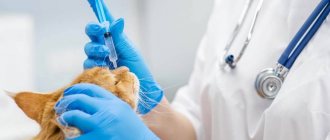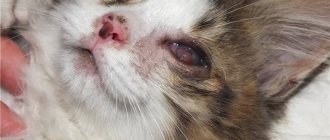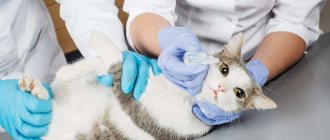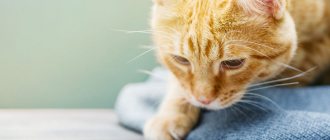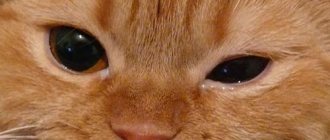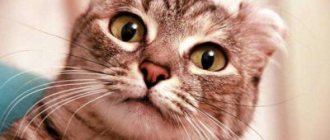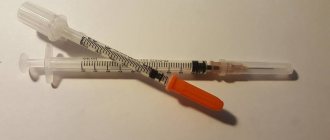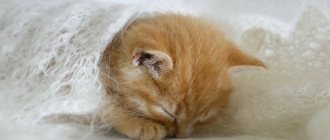Maria Alexandrovna Sazhko
veterinary therapist
Veterinarians are often asked to tell us how to wash the eyes of kittens and adult animals, so we decided to prepare a whole article on this topic.
Normally, a healthy cat or cat follows the rules of hygiene on its own, caring for the hair of the entire body, face and tail. Unfortunately, the animal is not always able to independently remove all contaminants from the eyes, skin and fur around it; in this case, the intervention of the owner is required.
It is important to always pay attention to the appearance and general condition of the pet and, if necessary, if you notice an unkempt appearance, extensive dirt or pain, immediately seek help from a doctor.
When is eye rinsing necessary?
This manipulation is necessary in a number of cases: prevention of secondary infection in case of injury, routine treatment of a contaminated eye in an animal predisposed to contamination, when removing mechanical contaminants and drug residues during treatment of an eye or systemic infection. Let's consider this issue in more detail.
Eye diseases
Conjunctivitis
– inflammation of the mucous membrane of the eye, that is, the conjunctiva, caused by a viral or bacterial infection, allergic reaction, injury, etc. Manifested by swelling of the conjunctiva, redness, active discharge and soreness.
Blepharitis
– an eye disease that affects a cat's eyelids. The eyes look swollen, discharge accumulates around them and dries into crusts, and there is itching and restlessness on the part of the animal.
Glaucoma
– this is a disease that develops as a result of increased intraocular pressure, manifested by damage to the optic nerve and retina. The chronic course of the disease can cause optic nerve atrophy, that is, lifelong blindness. The main manifestations are an increase in the volume of the eyeball, clouding, lacrimation, redness, etc.
Keratitis
– disease of the cornea of the eye. This pathology can be caused either by injury or be secondary to another eye disease. It manifests itself as swelling, lacrimation, clouding of the cornea, and when complicated by a secondary infection – itching and pain.
Cataract
– a rare disease, typical mainly for older animals, which consists of clouding of the lens of the eye. This change can be caused by chronic diseases of the animal - diabetes, trauma, intoxication, metabolic disorders, genetic predisposition, etc. Visually, this condition is noticeable only in the later stages.
Turn of the century
- A fairly rare disease in cats. This is a congenital problem or acquired as a result of long-term inflammatory processes, which is manifested by improper placement of the eyelid and eyelash margin. Most often, it turns inward, thereby constantly injuring the surface of the eye. Visually, this pathology manifests itself very characteristically, but the first thing that owners most often pay attention to is redness, increased discharge from the eyes, and anxiety.
More details about each disease can be found in the article.
Injuries
Mechanical damage to the surface of the eye most often occurs in cats that are on their own or live in contact with other animals. Injuries are caused as a result of mutilation by sharp objects, in fights, falls and other unforeseen situations.
This pathology is manifested by general inflammatory signs - discharge from the eye, swelling, anxiety on the part of the pet, pain. As a result, on the surface of the eye you can see swelling of the corneal tissue - a whitish surface. At the appointment, a doctor who suspects an eye injury conducts a fluorescein staining test. Thus, he details the extent and depth of the lesion - prognosis and further therapy depend on this.
Each disease is unique in its own way and requires an individual approach and prescription. But one thing remains common in treatment - in case of any inflammation, it is necessary to rinse the cat’s eyes and keep them clean. Before any manipulations, administration of drugs - drops or ointments, the owner must thoroughly treat the eye from mechanical impurities and secondary bacterial infections. In advanced diseases, the cat’s eyes have to be washed even to remove pus.
Anatomical features
Some cats have anatomical features of the nasolacrimal duct. For example, narrow, short, folded eye orbits, like exophthalmos, skin folds, occur in short-faced cats - Persians, exotics, Scottish folds. Owners of these cats often experience excessive tearing and tear tracks. Under the eyes of such cats, the secretion of the lacrimal gland often accumulates, in which, over time, harmful bacteria develop, causing a local inflammatory process, alopecia, itching and anxiety on the part of the animal.
It is important for such breeds to pay timely attention, treat and wash their eyes, ensure the prevention of bacterial inflammation, clean the skin and fur around them, without waiting for secondary changes.
How to wash the eyes of kittens and adult cats?
Folk remedies
To wash the eyes of a cat or kitten, you can use diluted infusions of tea or herbs. It is important to use solutions at a comfortable temperature that does not injure or burn.
The following options can be used:
- Strong tea or tea leaves.
To do this, you will need to brew strong tea/decoction and let it sit for 10–12 hours, or better yet, a day. It is important to use loose leaf tea or herbs, and not tea bags.
- Chamomile decoction.
One brewed bag of chamomile at room temperature is enough. It must be remembered that it can dry out the skin with frequent use.
- St. John's wort decoction.
This decoction must be used diluted.
- Calendula decoction.
An aqueous decoction made from calendula flowers. It is important to dilute it before using it for eye treatment.
Pharmacy products
You can use standard, readily available drugs from a humanitarian pharmacy.
- Sodium chloride solution 0.9%.
Standard saline solution used for intravenous administration. When used, it can be drawn up sterilely using a syringe. This way the remaining bottle will remain sterile and suitable for further use.
- Aqueous solution of chlorhexidine 0.01%.
It is important to pay attention to the concentration of the drug and the absence or presence of alcohol-containing substances in it.
- Furacillin solution 0.02%.
Also use low concentration.
Specialized means
A cat’s eyes can be washed at home with any of the following means, both as a preventive measure and in combination with medicinal drugs to treat any disease:
- "Diamond Eyes"
– a drug with chlorhexidine, taurine and chlorocide C. These cat eye drops are an antiseptic that can be used as a prophylaxis and, as a concomitant remedy, in the treatment of ophthalmic pathology.
- Eye cleaning lotion from any brand.
It is important to pay attention to the principle of use of the drug, prescribed in the instructions - usually they cannot be used against “tear paths” and in no case applied to the surface of the eye.
Hurry up, choose a box and find out what gift awaits you
Discount on pet insurance
Promo code copied to clipboard
How to wash the eyes of an adult cat?
As auxiliary means for eye treatment, you may need:
- a pipette or syringe without a needle for applying the drug to the surface of the eye;
- a cotton pad or gauze swab (or sterile rags) - to remove dirt and excess drug;
- a blanket - as a means of humane fixation if the cat has a negative attitude towards this procedure;
- treats as positive reinforcement - encouragement.
The main thing when washing your eyes:
- Calm
It is important to approach this manipulation calmly and carefully. Under no circumstances should you grab a cat and force it to cooperate with a rough fixation - in this way you can scare it forever, and the cat will greet each procedure like a wild animal.
- Humane fixation
It's easy to pick up a calm and loving cat. But what to do with an aggressive or touch-intolerant pet? This is where a blanket with a homely scent will come to the rescue. With caring movements, you need to wrap the cat in a blanket, thereby immobilizing it and giving it a feeling of security.
- Speech
It is important to continue talking to the cat throughout the entire procedure in a calm and quiet voice, even if the cat begins to be indignant. Your speech will make it clear to the tailed one that everything is fine and nothing threatens him.
- It is necessary to drop 2-3 drops of the solution we have chosen into each eye and let the animal blink several times. This will remove excess solution through the outer corners of the eyes, as if he were crying.
- Using a rag or napkin soaked in the selected solution, you need to remove excess and dirt accumulated around the eyes. Cleanse the coat and skin with gentle massaging movements. Do not injure your eyes under any circumstances. It is important to use a separate tissue for each eye.
If necessary, the prescribed drops can be dropped into the cat's already cleaned eyes again.
Removing Foreign Objects
Most often, upon examination, it is possible to notice a speck in the eye. If you can’t hook it with your fingers or tweezers, and the animal strongly resists, you should act differently by dripping Furacilin dissolved in water, saline solution, or simply boiled water and cooled to room temperature, previously slightly salted, into the inflamed eye.
The cat will begin to blink and help itself with its paws. This way the speck can come out along with the fluid flowing from the eye. Instillation or rinsing with a moistened swab should be repeated until the foreign body leaves the eye.
How to wash kittens' eyes?
Eye treatment for kittens is very similar to that for adult animals. The basic principle is a humane approach and gentle procedure with the aim of cleansing, but not causing further injury. For comfortable fixation, a blanket and warmth are also used; soft fixation is possible at the skin fold of the withers as an imitation of a mother cat. You should not hold the kitten suspended by the skin fold, thereby causing pain. If an adult kitten is unnerved by this approach, stop immediately.
It is enough to apply 1 drop of solution to each eye. If the kitten is very small, excess solution and dirt can be removed with a cotton swab.
After any unpleasant procedure, both an adult cat and a kitten must be rewarded with stroking, praise for good behavior and treats. In this way, we reinforce the animal’s good attitude towards any necessary manipulation - next time everything will go even easier. Doctors are wary of prescribing eye drops to kittens because of their high concentration.
Now that the question of how and what to wash the eyes of a kitten or cat at home has been discussed to the fullest, let us note what you need to pay special attention to so as not to harm your pet.
Disease prevention
In order for your pet to get sick less often, he needs to take preventive measures, namely:
- A small pet should wash its eyes daily;
- When playing with an animal, it is necessary to take all measures so that the kitten does not get injured;
- All vaccinations must be done on time;
- The animal's nutrition must be correct and balanced;
- Take your pet to the vet regularly.
Caring for your pet is a very important aspect of pet care. After all, this is the only way your baby will grow up healthy and happy.
Precautions
- Under no circumstances should alcohol solutions, antiseptics, or concentrates be injected into the eyes. This can cause a chemical burn to the surface of the eye.
- You cannot use plain water as a treatment - it disrupts the composition of the microflora of the eye and can dry out its surface.
- Do not use hot decoctions due to possible thermal burns.
- You should not use cotton wool or fibrous rags - the lint may get on the surface of the eye and may be difficult to remove.
- Do not use the same swab/cotton pad on both eyes. This way we can spread the infection from one eye to the other.
- Under no circumstances should treatment prescribed by a doctor be stopped without his knowledge and before the prescribed date.
Alarming symptoms
The disease begins with slight redness and swelling of the eyelids. The kitten squints one or both eyes, restlessly fingering the upper part of its muzzle with its paw, trying to get rid of the discomfort. Deterioration in health is often accompanied by the following symptoms:
- profuse lacrimation;
- purulent discharge from the eyes and nose;
- temperature increase.
The pet coughs and sneezes, refuses to eat and play, becomes lethargic and sleeps all day. Not only the kitten’s eyes fester, but also its nose, crusts form on the eyelids, and photophobia appears. Sometimes, due to frozen exudate, the kitten’s eyes do not open at all. Delay in such a situation can lead to deterioration of vision, and in some cases, loss of the eye.
How to care for your pet's eyes
It is necessary to monitor your cat's eyes starting from early childhood. The kitten opens its eyes starting from two to three weeks of age. If they do not open for a long time, you need to start treating them with gentle movements of an ear stick or a napkin moistened with one of the above solutions. It is important to remove all crusts and discharge immediately during the period of opening the eyes, which usually lasts for 2–3 days.
Normally, adult cats take care of their hygiene on their own - by licking their fur and washing their faces. It is important to pay attention to the condition of the cat’s coat - a healthy cat will always be clean, while a sick cat, on the contrary, will have a dirty, unkempt appearance. In this case, it is necessary to contact a veterinarian in a timely manner.
Prevention is important and is needed as needed - that is, in case of contamination. If the eyes and the skin around them are clean, no treatment is required.
Expert advice
Veterinarians recommend not to neglect hygiene procedures for your pets’ eyes. It is worth assessing the condition of the visual organs every day. Rinse eyes only with clean, fresh suitable solutions.
It is important to morally support your pet during these simple but extremely important procedures, to praise and encourage. If you have the slightest doubt about your cat's health, you should not put off going to the veterinary clinic. It is important to tell the doctor exactly what worries you, answer his questions and do not hesitate to ask your own, if any.
A cat's eyes are a delicate and very important organ. Thanks to them, pets navigate their environment, so it is necessary to pay attention to caring for your pet’s eyes.
Eye wash: the main thing
- Treatment and rinsing are the main methods of first aid and prevention of secondary infection for any diseases of the eyes of a cat.
- It is important to take care of your cat's eyes, starting from a young age and throughout her life.
- There are a large number of available products that can be used to wipe the eyes of both a kitten and an adult animal: decoctions of chamomile, calendula, an aqueous solution of chlorhexidine 0.01%, a solution of furacillin 0.02%, cleaning lotions.
- When treating an animal's eyes, it is important to use strictly aqueous and low-concentrated solutions.
- A special approach to the cat during the eye washing procedure predetermines its further attitude to any other therapeutic measures. It depends on him whether her attitude will be positive or negative.
- There are anatomical features of a cat's eye that predispose it to frequent contamination - it is important to pay attention to this and prevent secondary infections by periodically treating the eyes and skin around them.
- A very small kitten can be wiped with a cotton swab; for older animals, you can use cotton pads/gauze swabs.
Home treatment for eye infections
When a cat refuses its favorite food due to purulent discharge from the eyes, one can safely suspect acute inflammation. Most likely, it is infectious in nature and caused by bacteria. In this case, you need to apply antiseptics externally in the form of:
- Washing. For them, solutions and liquids with antibiotic properties are used: the same Furacilin, weakly diluted potassium permanganate, infusions of calendula or chamomile flowers, oak bark decoction, three percent peroxide or Chlohexidine. 3-4 times throughout the day, soak a tampon in one of the listed liquids and wipe your eyes. All solutions must be fresh, especially herbal infusions.
- Burying. Ready-made medications with antibiotic drops should be recommended by a veterinarian. However, in critical situations, you can use drops with Levomycetin Albucid, Tsiprolet, Sulfacetomide at home. Anandin relieves itching, minimizes swelling, and eliminates inflammatory redness. All drugs are used according to their instructions. The usual dosage for a cat is 1 - 2 drops in each eye up to 3 times a day.
- Mazey. This is usually Tetracycline eye ointment. You need to keep your pet's head immobilized, gently rubbing a small amount of the composition, previously placed on the drawn eyelid, twice a day.
